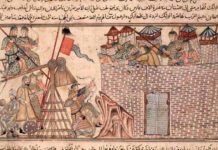At the end of the Cold War North Korea’s future looked bleak. The secretive regime, though nominally self-sufficient, was in reality heavily reliant on the Soviet Union.
According to experts in international politics, following the fall of the Berlin Wall in 1989, North Korea was supposed to suffer the same fate as the Communist countries of Eastern Europe; however the Pyongyang regime survived first the almost total defeat of Communism and, two years later, the collapse of the Soviet Union.
The opening up of China towards the West and its adoption of economic reforms during the 1990s dealt another blow to Pyongyang, but it was the death, in 1994, of Kim Il-Sung, the only leader that the country had ever known, that should have sounded the death knell for the world’s last Stalinist regime. Nevertheless, this small, isolated country, which certainly deserves the tag “the hermit kingdom” and which the western media routinely describes as mad, dangerous, unpredictable, or, the worst regime on the planet, has managed to survive, even if it certainly hasn’t prospered.
The End of the Cold War
The regime adapted to the new realities of international relations, exactly as it had done during the long years of the Cold War. During the 1990s Pyongyang tried, in spite of its weakened political and economic status, to extract as much desperately needed aid as possible from sworn capitalist foes such as the United States, South Korea and Japan, without offering the slightest meaningful concession. During this time North Korea became a past master in the art of illusion: the regime promised each time to open up, whether economically or politically, in exchange for humanitarian aid, but the promised changes never came, and these countries continued to provide aid throughout the decade, fearing the consequences if the regime collapsed.
In order to understand the very particular case of North Korea it is necessary to briefly examine the circumstances that led to its creation. North Korea and South Korea came into being whilst the Korean peninsular was temporarily divided by the USSR and USA at the end of the Second World War. It had been decided that the two countries would occupy and govern temporarily their respective sides whilst UN-supervised elections were organised. The Soviets obviously had no desire to see government decided by free and fair elections and knew that the only way to unify the country to their advantage was militarily.
The Soviet Union Organises the DPRK
The Soviet Union, therefore, began to reorganise the north of the country in its own image, and Kim Il-Sung, the commander of a small troop of Korean guerrillas which had fought against the Japanese occupation was chosen as leader. The USSR took the economic and political measures necessary for the creation of a peoples’ republic, and begun a series of purges to eliminate both the communists opposed to Kim Il-Sung and the nationalists hostile to this new form of colonialism. The Korean Worker’s Party is organised in the image of Moscow’s Communist Party and an agrarian reform launched. In the south of the country the Americans, unlike the USSR which had created a modern and well-equipped army for its new satellite, had left behind a defenceless South Korea which was at the mercy of its neighbour.
On the 25th June 1950, with the agreement of Stalin, Kim Il-Sung’s forces cross the 38th parallel and advance rapidly towards Seoul. It is the first stage of a ‘concertina war’ which firstly takes the North Koreans to the south of the peninsular, not far from Pusan, before the Americans enter the war under the flag of the UN and push them back the length of the country to the Yalu river, the natural border with China. The war takes another twist when a Chinese Peoples’ Volunteer Army comes to Kim Il-Sung’s rescue and the United Nations’ forces are chased back behind the 38th parallel. Seoul falls once again shortly afterwards, but the war stabilises progressively and the two sides are back at their starting point on the 38th parallel during the Spring of 1951. The armistice which was signed in July 1953 legitimised the 38th parallel as the border between the Democratic Peoples’ Republic of Korea (DPRK) in the north and the Republic of Korea (ROK) in the south.
The End of the Korean War
At the end of the war Kim Il-Sung’s regime had to confront a monumental rebuilding operation, not only because of the American bombardments which had largely destroyed North Korea, but also because the Japanese had tried to eradicate all traces of Korean culture and tradition during fifty years of occupation. It is because of this colonial past that both of the Koreas place such importance on being the true incarnation of the Korean national identity.
Unlike other socialist states, and probably because of its colonial past, North Korea is a country that has carefully cultivated its cultural and ethnic image since the birth of the regime. To this end, the country’s leaders invented the philosophy of Juche and have applied it to each part of society. The ideology of Juche, which is effectively a philosophy of independence and self-sufficiency was proclaimed for the first time by Kim Il-Sung on the 28th December 1955, but didn’t appear officially in the nation’s constitution until November 1970.
The goal of self-sufficiency, particularly for this small country of 21 million inhabitants which had isolated itself ideologically from capitalist countries and voluntarily from a large number of its communist brothers was unrealistic and short-sighted and was never close to becoming a reality. Even during the years of rapid economic growth which lasted until the mid-1960’s, North Korea was dependant on other members of the Communist Bloc, especially the USSR, to help with post-war reconstruction.
References:
- Pierre Rigoulet, “Corée du Nord, Etat voyou”, Paris, Buchet-Chastel, 2003.
- Philippe Grangereau, “Au pays du grand mensonge”, Le Serpent de Mer, Paris, 2001.








